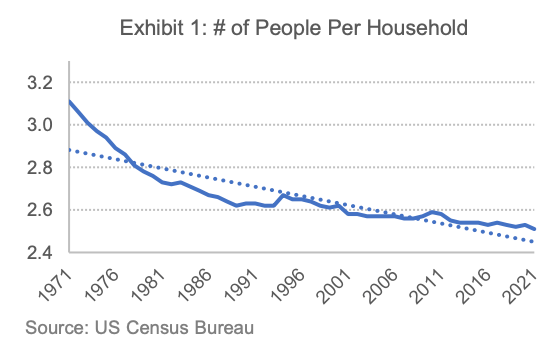Demand for housing is best quantified by the formation of new households. A household is defined as one or more people living in an individual dwelling unit, such as a family living in a home together, roommates sharing a rental unit, or an individual living alone. Household formation occurs when an individual or a group of individuals move from one household into a separate household, such as when a young adult moves out of their parents’ home to live alone, or with a roommate or partner, or when an immigrant (either an individual or family unit) moves into the country. These new households, by definition, need to move into a separate housing unit.
Because all households are not identical, they grow at a different rate than the population. For this reason, it is important to distinguish growth in households from population growth6. The US population increased by 150.4 million between 1960 and 2021, from 182.2 million to 332.6 million, for an average annual growth rate of 1.0%. If population growth was the sole contributing factor to household formation, the number of households would grow at an identical pace; however, between 1960 and 2021, the number of households grew by 74.3 million, or 1.5% on average per year, from 53.3 million to 127.6 million. This divergence in growth rates between population growth and household formation is a result of a second contributory factor: the declining number of people per household, according to Kingbird Analysis of US Census Bureau Data.

Between 1960 and 2021, the average household size declined from 3.33 people to 2.51, as shown in Exhibit 1, also according to Kingbird Analysis of US Census Bureau Data This decline is primarily driven by two factors. The first is the proliferation of nuclear family-oriented living arrangements, in which family households are increasingly constituted by parents and children only, rather than parents, children, and members of the extended family. For example, from the mid-1800s to the end of the 20th century, the share of US seniors living with their adult children declined significantly, from almost 70% to less than 15%, according to Ruggles Steven The Decline of Intergenerational Coresidence in the United States, 1850 to 2000 and American Sociology Review December 2007. This decline is the result of numerous factors, including enhanced resources and social safety net programs for the elderly, and increased employment opportunities for the young.
The second cause is the rise of non-family households as a share of total households. A non-family household is comprised of a householder who lives alone or with individuals they are not related to, such as an unrelated roommate. Non-family households’ share of total households increased from 14.6% in 1960 to 35.4% in 2021, according to Kingbird Analysis of US Census Bureau Data. As non-family households are typically much smaller than family households, at a historic average size of 1.39 people versus 3.35 people, respectively, this increase in their share of all households has had a large effect on overall household size. This increase is largely due to higher rates of independence among new adults, and cohabitation of unmarried roommates or partners.
The combination of a growing population and a decreasing average household size led to an acceleration of household formation relative to population growth. Between 2010 and 2021, the US population expanded 7.0%, by 21.6 million, from 311.0 million people to 332.6 million. If the average household size remained static at 2010’s 2.59 people per household, the number of households would have expanded by 1.1 million. However, the average number of individuals per household shrank to 2.51, resulting in annual household formation of 1.3 million households.





